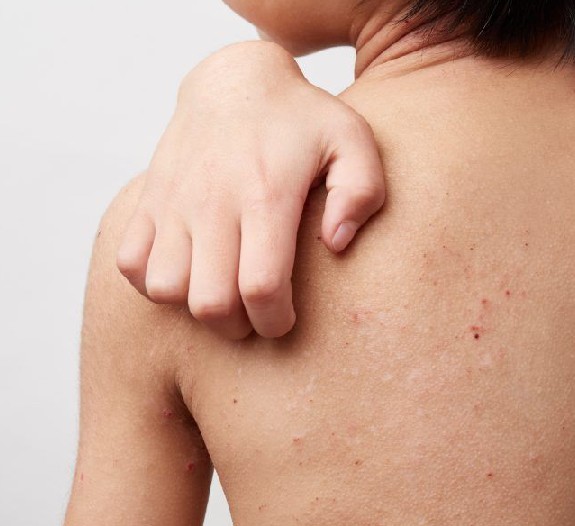
Symptoms
- Dry itchy and scaly skin
- Redness and rashes
- Scratching and itching
- Appears bumpy and develop knots in thickened areas
- Lichenification and weeping blisters when burst
Complications
If left untreated, atopic dermatitis may results in:
1. Asthma and hay fever
More than half of the children with atopic dermatitis develop asthma and hay fever by the age of 13.
2. Chronic itchy, scaly skin
Atopic dermatitis can cause the affected skin to become discolored, thick and leathery.
3. Skin infections
Repeated scratching that breaks the skin can cause cracks and open sores. These increase the risk of pathogen invasion and infection.
4. Irritant hand dermatitis
This especially affects people whose core work requires their hands to be wet and exposed to detergents, harsh soaps, and disinfectants.
5. Sleep problems
The itch-scratch cycle can result in poor sleep quality.
Treatment
It’s important to visit the dermatologist for treatment to control the disease and prevent it from worsening. Treatment includes medicines to control itching, reduce skin inflammation (redness and swelling) and get rid of the infection.
To prevent relapse, the dermatologist will also suggest lifestyle modifications that are very helpful and important to manage the disease.
Tips for people with Dermatitis
Ways to ease discomfort
- Make sure the humidity and temperature levels are comfortable.
- Apply moisturizer twice daily to make sure the skin does not get dry and cracks.
- Enquire your doctor about how to use wet wrap therapy and its effects.
- Make sure your child’s fingernails are cut short and smooth.
- Avoid the use of perfumes, dyes, and detergents that can irritate your skin.
Bathing care
- Bath your child with warm water not with hot water and make sure you complete the bath within 5-10 mins.
- Just pat the skin after the bath with soft cotton towels and don’t make it dry completely.
- Apply for the medicine if advised after bath. Make sure you apply for the medicine before the skin gets completely dry.
- Apply moisturizer over the medicated skin.
- Avoid bubble bath and prefer a bleach bath every two days if the skin is infected. Bleach bath reduces inflammation and kills the pathogen.
Choosing the right clothes
- Wear skin-friendly cotton clothes.
- Use a limited amount of detergents to wash the clothes.
- Rinse the clothes with an adequate amount of water and dry them completely under direct sunlight.
- Wash new clothes with plain water before wearing to your child to remove excess dyes and fragrances.
- Synthetic and wool clothes must be avoided.
In case you have a concern or query, you can always consult an expert & get answers to your questions!
 Whatsapp
Whatsapp Facebook
Facebook Twitter
Twitter Instagram
Instagram Linkedin
Linkedin Pinterest
Pinterest